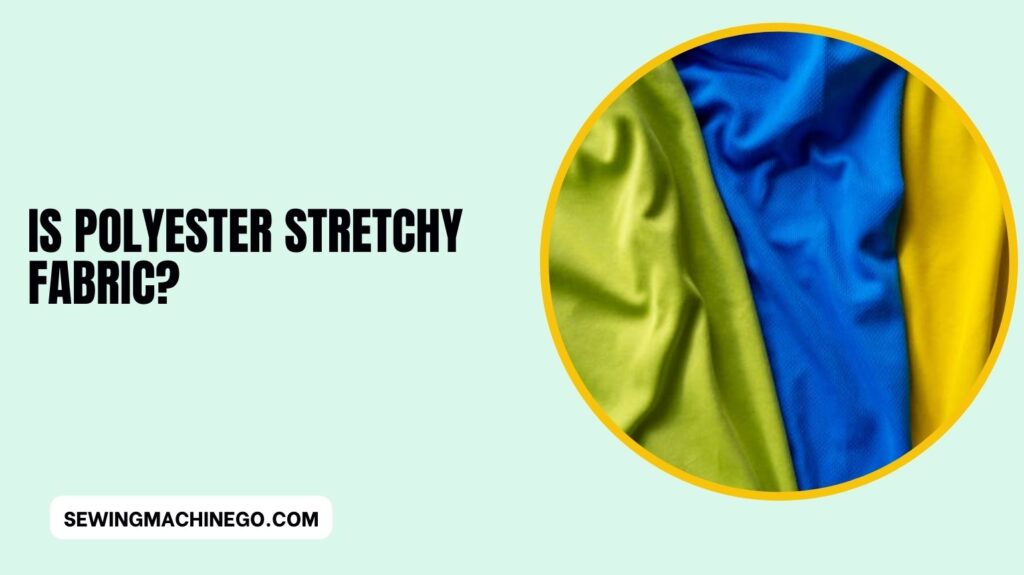Is Polyester Stretchy Fabric? (Polyester Fabric Guide) In 2024
Polyester, a widely utilized synthetic fabric, prompts inquiries about its stretchiness. Is Polyester Stretchy Fabric? Often associated with durability and resilience, polyester’s stretch capabilities remain a subject of curiosity.
Understanding the inherent characteristics of this material, its composition, and the factors influencing its elasticity is essential in determining its suitability for various applications.
Delving into this query unveils the nuances surrounding polyester’s stretchiness and sheds light on its potential for providing comfort and flexibility in clothing and other uses.

What Makes Polyester Stretchy?
Contrary to popular belief, pure polyester isn’t inherently stretchy. Its stretchiness often comes from its blend with other materials like elastane (spandex) or lycra. T
hese blends enhance its elasticity, making it suitable for stretchy apparel like sportswear, leggings, and activewear.
Polyester Blend Fabrics
The combination of polyester with elastane or other elastic fibers creates a fabric that retains the strengths of polyester while gaining stretch properties. This blend caters to consumers seeking both comfort and flexibility in their clothing choices.
Mechanism Behind Polyester Stretchiness
The stretchiness in polyester fabric is due to the molecular structure of the added elastic fibers. Elastane or spandex has unique properties that enable the fabric to recover its original shape after stretching, providing a comfortable and snug fit.
Advantages of Stretchy Polyester
Stretchy polyester offers wearers freedom of movement, comfort, and shape retention. Its resilience and resistance to wrinkles and shrinking contribute to its popularity in the fashion industry.
Disadvantages and Limitations
Despite its benefits, stretchy polyester has limitations. Over time, it may lose its elasticity, causing the fabric to sag or become less form-fitting. Additionally, some individuals may experience allergic reactions to polyester blends.
Applications and Uses
The stretchy nature of polyester finds applications in various industries, from fashion to healthcare. It’s used in athleisure wear, medical garments, swimwear, and more due to its flexibility and durability.
Polyester Care Tips for Maintaining Stretchiness
To prolong the stretchiness of polyester garments, proper care is essential. Washing them in cold water, avoiding excessive heat, and air-drying can help retain their elasticity.
Here are some tips for maintaining the stretchiness of polyester:
- Washing Instructions: Always wash polyester garments in cold water. Hot water can cause shrinkage and damage the elasticity of the fabric. Use a mild detergent to preserve the material’s integrity.
- Gentle Cycle: Opt for the gentle cycle on your washing machine. Aggressive washing can strain the fibers, leading to reduced stretchiness over time.
- Avoid Excessive Heat: Refrain from using high-temperature settings while washing or drying polyester items. Heat can degrade the elastic properties of the fabric.
- Air-Dry Instead of Machine Dry: Air-drying is the best method for maintaining stretchiness. If you must use a dryer, choose the lowest heat setting or tumble dry on a low setting to prevent damage.
- Avoid Ironing: Polyester fabric often doesn’t require ironing. However, if necessary, use a low-heat setting and avoid direct contact with the fabric to prevent heat damage.
- Store Properly: Store polyester garments by hanging them instead of folding them to prevent undue stress on the fibers. Avoid hanging them in direct sunlight, as prolonged exposure can weaken the fabric.
- Handle with Care: When washing or handling stretchy polyester, avoid rough or abrasive actions that might stretch the fabric beyond its elastic limit.
- Separate from Abrasive Materials: Wash polyester separately from rough fabrics like denim or garments with zippers or Velcro to prevent friction damage.
- Avoid Bleach and Harsh Chemicals: Chlorine bleach and harsh chemicals can degrade polyester fibers and affect their elasticity. Use mild detergents or those specifically designed for delicate fabrics.
- Follow Manufacturer’s Instructions: Always refer to the care label on the garment for specific washing and care instructions. Different blends of polyester may have varying requirements.
Comparison with Other Stretch Fabrics
Compared to natural stretch fabrics like cotton or wool, stretchy polyester exhibits better shape retention and resilience. However, each fabric type has its unique properties catering to different consumer needs.
Sustainability Concerns
Polyester, while versatile and durable, poses sustainability concerns due to its production process heavily reliant on non-renewable resources like petroleum.
The primary issue lies in its non-biodegradable nature, contributing to environmental pollution and landfill accumulation.
Additionally, the microfiber shedding during washing releases harmful particles into water bodies, impacting aquatic life. Despite its stretchy quality, the environmental implications of polyester production raise significant sustainability challenges within the fashion and textile industries.
Innovations in Stretchy Polyester
Polyester, often hailed for its durability, has been reimagined with innovations that have elevated its stretchiness. Traditionally known for its resilient nature, advancements in polymer blends and textile engineering have unlocked a new dimension for polyester as a stretchy fabric.
These innovations involve intricate molecular alterations and weaving techniques, resulting in a polyester that offers remarkable elasticity without compromising its inherent strength and shape retention.
The evolution of stretchy polyester has revolutionized various industries, from fashion to sportswear, offering unparalleled comfort and versatility.
The Future of Stretchy Polyester
Polyester, renowned for its durability and ease of care, has been revolutionizing the textile industry with its stretchy variants.
Manufacturers have ingeniously engineered polyester blends with elastane or spandex to create fabrics that offer remarkable stretch and recovery.
This innovative fusion has paved the way for versatile clothing, enhancing comfort without compromising on style.
As technology advances, the future of stretchy polyester fabric seems boundless, promising even greater flexibility, breathability, and sustainability in fashion.
People also ask – Is Polyester Stretchy Fabric?
Should I size up in polyester?
Polyester fabric doesn’t shrink as much as natural fibers, so sizing up might not be necessary unless you anticipate significant shrinkage or want extra room for comfort.
It’s always a good idea to check the fabric’s care instructions and consider pre-washing to gauge any potential shrinkage before cutting or sewing.
Is 100% polyester stretchable?
Pure polyester fabric typically doesn’t have inherent stretch like spandex or elastane.
However, some polyester blends or knits might contain added stretch fibers like elastane or Lycra, giving the fabric stretch properties. Pure 100% polyester fabric itself doesn’t have natural stretch.
What does 100% polyester feel like?
100% polyester fabric can feel smooth, soft, and silky, resembling the texture of natural fibers like silk or cotton.
It’s often lightweight, durable, and can have a slightly slippery or slick feel, depending on the specific weave or finish applied to the fabric.
Is polyester Flexible?
Pure polyester fabric doesn’t have natural flexibility or stretch. However, certain polyester blends or fabrics with added stretch fibers like elastane or spandex can offer flexibility and stretchiness, allowing for more ease of movement.
Conclusion
In conclusion, while polyester fabric is known for its durability and resistance to wrinkles, it generally lacks significant stretchiness compared to other materials like spandex or elastane.
Its limited inherent elasticity can be enhanced through blending with stretchier fibers.
Polyester’s primary strength lies in its strength and easy-care properties rather than its stretchiness, making it suitable for various applications where stretch is not the primary requirement.

Hi, I am Alice, and I am your perfect guide to the world of sewing machines. With over 10 years of experience in the sewing industry, I am passionate about sharing my knowledge and expertise to help you make the most of your sewing journey. about me






